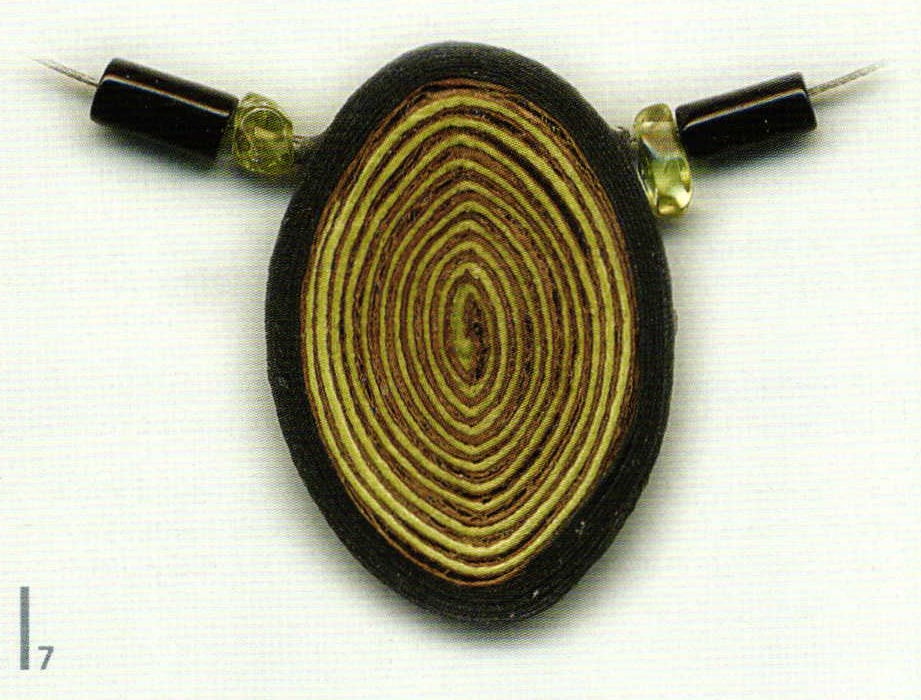Paper Has Many Faces
3 Minute Read
In previous centuries, paper was immensely precious. Today it has become a run of the mill product without any particularly high demands for its various purposes and uses. But numerous jewelry designers have restored it to its former value. They create designs expressing the whole variety and masterful transformation, the filigree delicacy and the inherent motion.
"Paper", says the artist Katrin Enstrup, "is a lively material with numerous aspects, moldable and flexible." No other material combines such a richness of diversity in colorful expression with the lightness that is so characteristic of paper. In order to design paper, one must be familiar with its properties and responses to processing. There are now roughly 3,000 different kinds of paper. All of them have special advantages and offer particular possibilities for expression. The most important are listed in the summary on page 64.
If it is machine-produced, paper has a grain. This is the direction of the drum over which the paper is rolled and pulled during production. In this context, the paper fibers are ordered parallel to the direction it rolls in. This is particularly important if paper is to be torn or glued. Paper can only be torn smoothly along the grain. If two pieces of paper are to be stuck together with water-based adhesives, water, paste or glue, it is advisable to stick them with parallel grains. This is the only way one can expect satisfactory results. It is helpful to press them together between two boards until they are fully dry. A piece of plastic should also be inserted in order to avoid the boards sticking to the paper.
Conversely, if one wishes to make stable cardboard out of several layers of paper, the grains in the different layers must run opposite to each other. The result is astonishingly stable - just like plywood, which is manufactured according to the same principle: lf the paper is very thick, grain is also important if it is to be folded, as paper can only really be folded properly parallel to the grain.
Thanks to its lightness, paper has the advantage that women wearing jewelry made from this material will barely notice a thing, even if its format is rather large. There are absolutely no limits to the richness of color; accordingly, fantasy can be boundless, emphasizes Marion Gunther, who also focuses intensely on paper jewelry. Her paper pearls are rolled individually and then fixed using the various glue mixtures, depending on the desired effect. After this, the paper pearls are formed and processed on the litho stone using the folding tool. The high-quality, long-fiber and mostly hand-dipped papers are made resilient after drying by grinding and waxing.
Several work stages are often necessary in order to lend paper pearls, for example, strength, gloss and resilience. A combination with traditional jewelry materials such as pearls, silver, glass, gold or genuine stones reveals an enchanting interplay between the different temperaments in so different materials. This aspect is masterfully implemented by Annamaria Zanella in her compositions of great charisma. "Objects trouvés", iron, steel, textile or papier maché as a so-called "materiali poveri" are interspersed with finest elements made of gold and made to glow due to clever, colorful and graphic designs.
Jewelry designers like Gudrun Meyer take other paths. Delightful effects are created using wallpaper, art prints or even newspapers. But one thing is true of them all: every item is unique. Katrin Enstrup packs her chains in a small box. It also contains a miniature photo of the art print that was used or a sample of paper with a brief explanation of the handicrafts used.
by Peter Henselder
You assume all responsibility and risk for the use of the safety resources available on or through this web page. The International Gem Society LLC does not assume any liability for the materials, information and opinions provided on, or available through, this web page. No advice or information provided by this website shall create any warranty. Reliance on such advice, information or the content of this web page is solely at your own risk, including without limitation any safety guidelines, resources or precautions, or any other information related to safety that may be available on or through this web page. The International Gem Society LLC disclaims any liability for injury, death or damages resulting from the use thereof.
The All-In-One Jewelry Making Solution At Your Fingertips
When you join the Ganoksin community, you get the tools you need to take your work to the next level.
Trusted Jewelry Making Information & Techniques
Sign up to receive the latest articles, techniques, and inspirations with our free newsletter.
